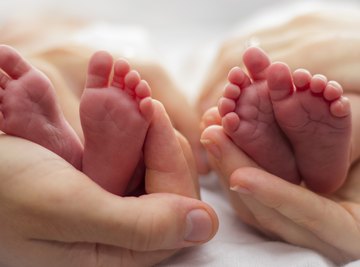
A genotype is the set of specific DNA instructions for an individual organism, much like the code that runs a software application. The specific DNA of an organism is inherited from its parents. A phenotype is an intricately related concept; it represents every possible way that the genotype manifests itself in the organism. Phenotypes range from a tulip’s color to the sound of a specific blue whale’s song to the red blood cell production in the bone marrow of a first-grader. Biologists have mapped the list of genotypes for specific traits for a variety of species. Most famous, perhaps, was Gregor Mendel and his pea plants. Human blood types are another well-known list of genotypes. However, many factors make genotyping a complicated business.
TL;DR (Too Long; Didn't Read)
A genotype is the specific DNA that an organism inherits from its parents. A phenotype represents every possible way that the genotype manifests itself in the organism. Since each organism has its own unique genotype, there is no possible way to list all genotypes. However, some human traits have been genotyped. These traits are examples of Mendelian inheritance because they are simple cases that involve inheriting one allele from each parent with no complications interfering with the phenotype.
Discoveries About Genetics
Because each individual organism – other than organisms that clone themselves and monozygotic, or identical, twins – has its own unique genotype, there is no way to list all genotypes. Scientists estimate that we have not yet discovered between 2 million and 1 trillion of the existing species on Earth, much less mapped their genomes or identified the genotypes of every living individual. This is not even possible to do for humans because babies are continually being born at a rate of about 250 every minute. While geneticists around the world completed the task of mapping the human genome in 2001, there are constant discoveries still being made about human genetics, especially with regards to interactions with environmental influences.
Mendelian Inheritance
Some human traits have been genotyped. Examples include widow’s peaks, attached earlobes, cheek dimples, freckles, and diseases such as:
- Huntington’s chorea
- hemophilia
These traits are examples of Mendelian inheritance because they are simple cases that involve inheriting one allele from each parent with no complications interfering with the phenotype.
Incomplete Penetrance
Many human traits are complicated and cannot be simply predicted by the inheritance of one allele from each parent. Biologists have a clear understanding that both nature (genetics) and nurture (environmental influences and life events) affect human phenotypes from our cellular activities to our physical appearances and behavior patterns. However, there is no clear formula about how much nature and how much nurture go into each human trait, and the ratio seems to be different for each individual.
For example, some genes are incompletely penetrant, which means they do not affect the individual’s phenotype unless certain conditions are met in the environment. If a person inherits genes that can cause autoimmune disorders such as multiple sclerosis or lupus, the individual is unlikely to express that phenotype by getting the disease in the absence of a significant physical stressor like a virus or tobacco or drug abuse. Much of this is related to a concept called epigenetics, which has to do with environmental influences on the chemical reactions in the body that activate or deactivate certain parts of the genome at specific times.
Complicating Factors
There are other reasons that so many human traits cannot be listed as simple genotypes. Many traits are determined by multiple alleles on different loci, which are spots on the chromosome. These traits are much more common than the approximately 18,000 Mendelian inheritance traits that are determined by one allele from each parent.
Another problem for determining lists of genotypes for human traits is that genotyping traits requires a clear notion of phenotypes. The phenotype is an abstract concept, however. There are nearly infinite levels of phenotypes for any individual. One phenotype can describe the enzymatic functions of a person’s liver cells, the size or color of their liver, the rate of metabolism of alcoholic beverages through the liver compared to a person of the same weight, age and gender, or their behavioral tendency to drink alcohol to excess, and so on.
While some human traits cannot be influenced by the environment, such as blood type, others can. Height is influenced by malnutrition, early trauma or disease. Vocal patterns are influenced by socialization that typically teaches girls to speak in a higher pitch and boys to speak in a lower pitch. It is often impossible to fully tease genotype apart from environment.
References
About the Author
Rebecca E. received a degree in human development before attending graduate school in writing. She has an extensive background in cognition and behavior research, particularly the neurological bases for personality traits and psychological illness. As a freelance writer, her specialty is science and medical writing. She's written for Autostraddle, The Griffith Review and The Sycamore Review.
